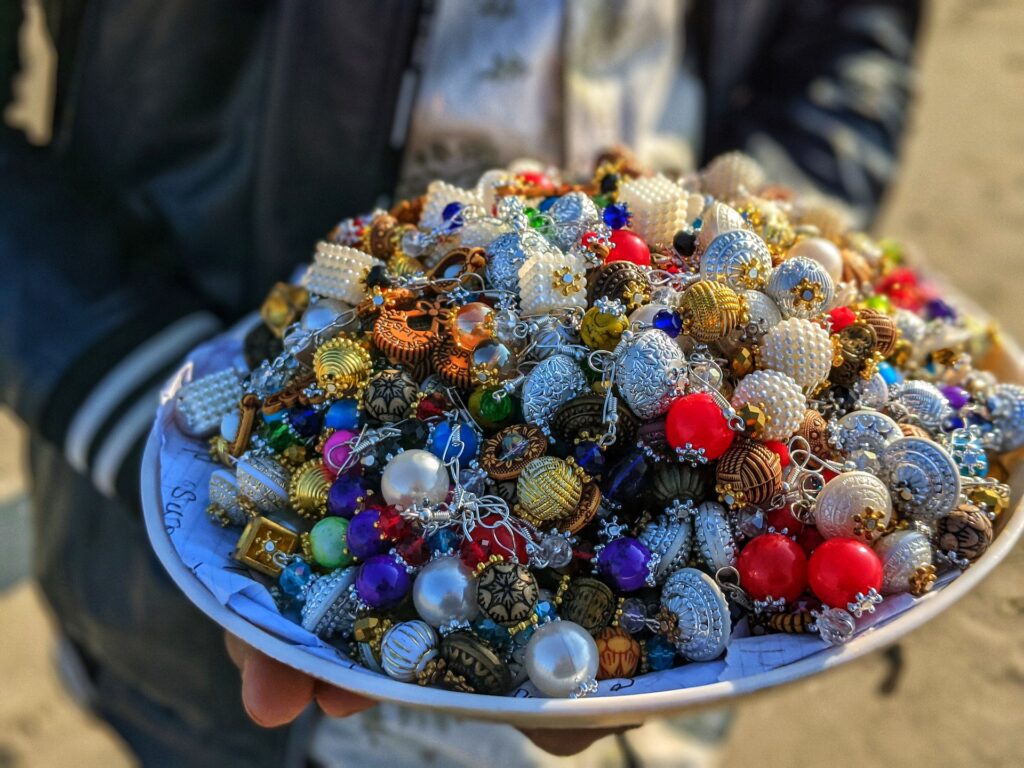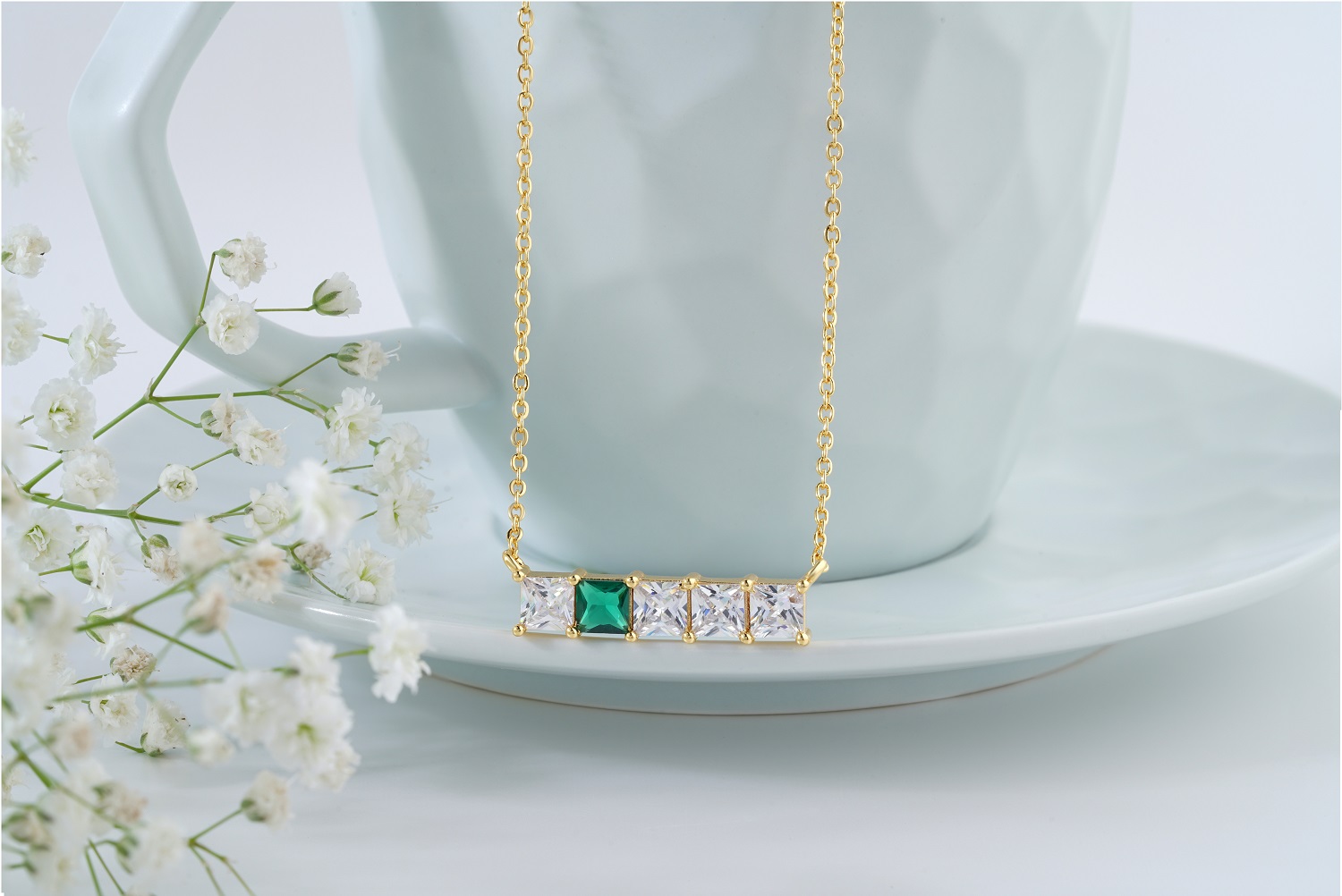A piece of jewelry is completed when the clasp and cord ends are attached to the beads that have already been knotted on the cord.
Ends for cords can be found in a wide variety of sizes, shapes, and styles to accommodate a wide range of cord diameters. For example, adding a clasp to knotted jewelry almost always necessitates using cord ends.
Jewelry closures can be found in various dimensions, forms, and designs. Suppose you’re working with jewelry for the first time. In that case, you may be interested in investing in higher-quality findings like gold-filled findings, as they protect the jewelry from falling apart once worn.
Always think about the size and type cord used and the design of the finished jewelry when choosing clasps and cord ends for knotted crafts.
Tiny beads strung on fine cord require similarly delicate clasps. The larger beads and heavier cord require stronger cord ends and clasps to ensure the beads and cord stay put. It’s often a matter of taste when deciding between these options.
Thinking About Cord Ends
Most knotted jewelry will require a cord end to be attached before a clasp can be added. Cord ends come in various shapes and sizes to accommodate the wide variety of cords available. Picking cord ends that are the right size and style for the cord being used will ensure the best possible results.
Knotting cords with a narrow diameter, such as silk, nylon, and waxed linen, are threaded through beads at the ends. The knots at the end of the cord are held in place and hidden by them. Three distinct kinds of bead tips are available.
The points of basket beads are miniature baskets. The knot is glued into place after being threaded through a hole in the bead tip’s “basket.” The “handle” of the basket is made by using round-nose pliers to form a loop from the hook at the end of the bead. Before closing the loop entirely, the clasp is attached to it.
The ends of clamshell beads can be either a hook or a loop, giving them the appearance of a clamshell when viewed from above. The knot is located in the space between the cups of the shell, which is reached by threading the string through a hole in the joint. The knot is secured with glue, and the cups are then closed over it. Clasps are typically fastened to the open hook or closed loop on the clamshell bead’s pointed end.
Beads that close on the side resemble a locket, with an open hook or closed loop at the top and two open cups. This particular bead tip design does not allow the cord to pass through. Instead, the knot is formed after the cups are closed around it. The hook or loop at the top of a side-closing bead serves as a connection point for the clasp.
Traditional alternatives to a bead tip include bulk, also known as French wire or gimp. This coiled wire tube is invaluable for its fineness, flexibility, and portability in working with silk cord and pearls. In addition, the silk cord is safeguarded from wear caused by the metal findings by sliding bulkheads at both ends of the jewelry design.
Waxed cotton, satin, and leather are some thicker cords that benefit from crimp findings. Crimp findings attach a clasp to the ends of a necklace or bracelet’s cord instead of crimp beads, which are only compatible with flexible beading wire. These findings are the foundation for the closure, which comprises rings and clasps.
Metal coils with a loop at one end, known as “coil crimps,” are designed to slip over and adhere to spherical stringing materials. The looped end can be fastened with a clasp or ring. The metal color of a coil crimp can be matched to the color of a clasp or another type of finding. They are available in various sizes to suit varying thicknesses of round cords.
U-shaped metal findings with a loop on one end are called fold-over crimps. First, pin the edges around a flat or round stringing material. Then, jump rings can quickly and easily attach a clasp to the looped end. Metal fold-over crimps are available in various colors to coordinate with clasps and other jewelry components.
Ribbon crimps, also known as crimp ends, are metal findings that resemble jaws and have a loop on one end. There are ribbon crimps with teeth and those without. They’re glued or clamped onto some flat stringing material.
Barrel caps, end caps, and bullet ends are all names for glue-on terminations. This alternative finding is perfect for ropes and cords with a larger diameter. They are available in many sizes to accommodate various diameters of thicker cords. Adding a clasp is as easy as gluing the cord into the end cap.
Mastering Jewelry Findings

Most knotted jewelry also has a clasp so that it can be easily opened and closed. Pearl clasps, also known as fishhook clasps, are commonly used to secure a necklace that has been knotted. Clasps like lobster clasps, spring rings, and toggles are also commonly used to secure knotted jewelry. The more elaborate clasps, such as S-hooks, J-hooks, and magnetic clasps, are used to complete knotted jewelry.
There is a wide variety of clasps to choose from. Choose a clasp for your knotted jewelry based on your plan to use it and your preference.
Two-piece clasps, known as barrel clasps, screw together to form a whole. Many sizes, styles, and materials are available for this clasp.
As the name implies, a box clasp consists of a box and a small, pressure-fitted piece that snaps into the box. Tiny snap locks are an added security feature on some box clasps. Bracelets and necklaces alike would benefit from this clasp’s use. From plated to precious metals, box clasps can be found in various sizes, shapes, and decorative patterns.
J-hooks are metal pieces with rings or jump rings soldered to each end. This clasp is ideal for necklaces and is offered in both minimalistic and ornate designs. Sizes, shapes, and materials for J-hooks can vary widely.
Thin, one-piece clasps in the form of a long drop with a flexible snap closure are what we call lanyard clasps. Most commonly, this clasp is used for macramé projects involving hemp or leather identification lanyards. The fasteners used in lanyards are typically made of plated metals.
Lobster claw clasps are a popular and reliable choice when working with crimp beads and beading.
It’s possible to use them with any jewelry finding or stringing material. Different sizes, styles, and metals (from plated to precious) are available for this clasp that resembles a lobster claw.
The two halves of a magnetic clasp are held together by a powerful magnet. This closure is an excellent alternative to lobster claws and spring rings for lightweight jewelry and those with limited dexterity. Many different styles and strengths of magnetic clasps are available.
Oval-shaped pearl clasps with intricate filigree work are classic accessories. The hook and snap closure of this clasp provides an additional layer of protection. While historically made from precious metals, pearl clasps can now be found in various materials.

